Chef Andrew Hunter: Bringing Flavor to the Masses
CULINARY POINT OF VIEW
As an R&D chef, Andrew Hunter thrives on the challenge of translating high-end culinary dishes and concepts into affordable food for the masses. His mantra: “Flavor doesn’t have to be expensive.” Relying on smart compromises that don’t sacrifice the integrity of the food, Chef Hunter works with companies like Kikkoman and Niman Ranch to successfully bridge culinary and sensory sensibility with the manufacturing or production realities.
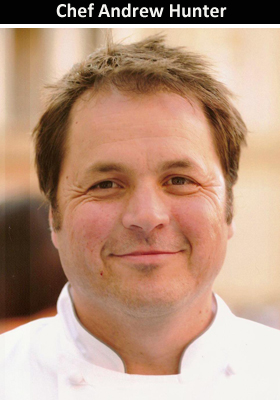 And to think...it all started scrambling eggs for his parents.
And to think...it all started scrambling eggs for his parents.
KELLY HENSEL: When and how did your love for culinary begin?
Andrew Hunter: I don’t remember not wanting to be a chef. I don’t really know when or how I even discovered what a chef was. My dad was a pharmacist and my mom was nurse and nursing professor. But even at the age of five or six if you asked me what I wanted to be, I said a chef.So my parents encouraged me and let me pull a stool up to the stove and scramble eggs. My parents said that my eggs were the best eggs they had ever had. As a five or six year old, you know, that’s all you ever need to hear.
The deal was they would buy the ingredients and I would cook dinner parties for them. I’m sure there were some really horrendous ones. Through the years I conceivably got a little bit better. Then, my first job was frying donuts, which as a 15 year old with a challenged complexion, wasn’t a really good thing. Nonetheless, it’s what got me started. Then I went on to the CIA [Culinary Institute of America].
HENSEL: As you said, you went to the CIA to study culinary. Where did you decide in your educational career or in your post-collegiate career to focus on R&D and product development?
HUNTER: I don’t know if I can pinpoint it exactly, but because I did grow up in a family that put a lot of emphasis on education—in some ways education for education sake—I was curious and motivated. So, after I graduated from culinary school, I went back to get my BA in culinary history.
I thought that I wanted to teach, but I wanted to do it in a non-traditional environment. In other words, I didn’t want to teach in a culinary school, which was my motivation to get a Master’s Degree in museum studies. Both of those degrees definitely influenced and informed me about food in a way that my peers weren’t influenced and informed.
Another really pivotal moment for me was when I moved to San Francisco to work for a chef named Barbara Tropp at the China Moon Café. Barbara was and still is—even though she’s passed away—a mentor. I often do something in the kitchen and wonder what Barbara would think of the flavor. Then I adjust and enhance according to what I think she might say. Barbara had a Ph.D. in what I think was third century or eighth century Chinese poetry. When I was working at the China Moon, I was getting my degree in culinary history. She and I became fast friends as a result. That was part of the mentoring.
There was also another experience when I was living in San Francisco. It’s funny that I can still remember the name, but I used to go into a pizzeria called Ernesto’s with a couple of friends. At the time I was like 24 years old and there were two guys probably in their 50s sweating bullets behind the line. I said to my friends who weren’t in the food business, that’s what I never want to be. I never have had a desire to be behind a single stove night after night after night.
So anyway, I think it was a combination of my upbringing for education and watching my father work away in one or two of his pharmacies which I equated to being a chef. In many ways it’s very similar. All of those things combined led me away from being a traditional chef in a traditional restaurant.
HENSEL: So how did it come about that you had the opportunity to work for Wolfgang Puck and other companies like that?
HUNTER: Well, the Wolfgang Puck opportunity came about through a typical recruiting opportunity. We were living in San Francisco at the time, my wife and I. We had two children and we had just bought a house and I didn’t want to go to Los Angeles. I remember my wife, who is smarter than I am, said “It’s okay, you don’t need to go, but Wolfgang Puck doesn’t call very often and he won’t call twice.” So we picked up and moved to Los Angeles.
It was unequivocally the best move I’d ever made professionally. Not only was it great to work with and for Wolfgang and subsequently clients and other people in the industry, but Los Angeles is just a better place for a chef like me to be with regard to what’s happening not only in the specific part of the industry, but also the peripheral industry.
So, for example, I’m not sure I would have gotten the experience or opportunity to be on Supermarket Superstar [Lifetime cooking reality show] had I not been living in Los Angeles. If I had been living in Dallas or Des Moines or even back in San Francisco, it probably would have been less likely to have that opportunity.
HENSEL: You helped at Wolfgang Puck to develop some of the menu items for his line of fast casual restaurants. You also helped develop his frozen line of products for supermarkets.
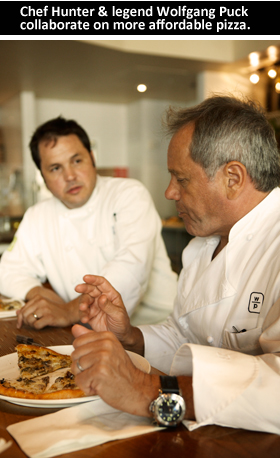 How does your process or approach to challenges like that differ from working for a food manufacturer such as Kikkoman and what they ask you to do? Is it very similar or how do you kind of balance your culinary side with meeting the client’s needs?
How does your process or approach to challenges like that differ from working for a food manufacturer such as Kikkoman and what they ask you to do? Is it very similar or how do you kind of balance your culinary side with meeting the client’s needs?HUNTER: Well, let me first say that Wolfgang was doing the retail items really long before I came on the scene. Wolfgang was one of the first. Wolfgang has been the first in a bunch of different areas of the food business as a chef. He was really one of the first to develop pizzas and other restaurant quality items at retail.
So, I don’t want to take credit for what I didn’t start, but I definitely worked with Wolfgang and many of the items that are on the shelves today I developed. My task with Wolfgang was not very different from what I do with other clients whether they be restaurant clients or manufacturing clients. My job with Wolfgang was to translate fine dining items into compositions that worked in fast casual dining and also in retail.
One of Wolfgang’s signature items at Spago over the years has been meatloaf, but it’s an amazing meatloaf. His meatloaf uses beef and veal. I think the original one also used lamb all in combination. There’s a really wonderful creamy vegetable composition that goes inside. It’s all wrapped in bacon. So it’s really less of a meatloaf and traditionally more of a tureen. So my job was to take meatloaf that sold for around $32 at Spago and make meatloaf that matched the quality standards and be able to sell it for $12.95. So you make compromises. I wasn’t allowed to compromise on using a quality of meat that didn’t meet the humane natural standards, but I didn’t try to use veal and lamb. I just used beef.
You make compromises along the way, but don’t compromise the integrity of the food. For example, there’s a pizza on the menu in one of Wolfgang’s Las Vegas restaurants that I was intrigued by. It was meatball with porcini mushrooms. Porcini mushrooms are really expensive, and making meatballs is a labor intensive task, but what I knew was if I cooked crimini—which was in my price point—and roasted them with a little bit of soy sauce and some garlic and seasonings, they would be delicious.
If instead of making meatballs I used the trim from the meatloaf that we were already making, then I would essentially have meatballs. So we cross utilized and made compromises. But at the end of the day your flavor profile has to be delicious. I like to say to my clients whether it’s someone like Kikkoman or restaurant company client, flavor doesn’t have to be expensive. That’s one of my mantras.
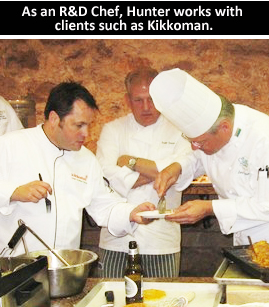 What I try to be is a bridge between the culinary sensibility from all of the sensory attributes—the look, feel, flavor, texture, and aroma—and the manufacturing or production realities. Again, it’s about compromising, but making good, smart compromises and hold to your principles on things that you cannot compromise on.
What I try to be is a bridge between the culinary sensibility from all of the sensory attributes—the look, feel, flavor, texture, and aroma—and the manufacturing or production realities. Again, it’s about compromising, but making good, smart compromises and hold to your principles on things that you cannot compromise on.HENSEL: You had mentioned humane farm animal treatment. You helped to initiate a program while at Wolfgang Puck that dealt with that. How has that shaped what you do for other clients?
HUNTER: It was certainly part of what I thought was right, but it wasn’t anything that I had implemented with business accountability before working at Wolfgang. It was really an important project for me and really shaped the way that I do business today. It developed a long-standing relationship with Niman Ranch for whom I’m the Executive Chef and have been since I transitioned out of fulltime work with Wolfgang.
Now, I also work with Alaska Seafood Marketing Institute, which is a marketing group. Sustainability is written into the Alaska Constitution. Any seafood that comes from Alaska, it’s not even a conversation. It has to be part of a sustainable program. Another client is the Irish Dairy Board which makes Kerrygold cheese. Part of the reason that cheese is so amazing is that they treat their cattle in a humane and sustainable way.
So, when I think about this I really connect sustainability to humane treatment. I don’t believe that you can treat your animals in a humane way without practicing sustainable agriculture. I don’t understand why you would practice sustainable agriculture without treating your animals in a humane way.
But you have to go back to business accountability; we still had to make money, right? It really goes back to making smart compromises. One of the things that we decided at Wolfgang was that the humane piece was really critical. That was really what he cared about.
So, if we’re going to use humane ingredients or products from humane agriculture and sustainable agriculture, then we’re not going to worry about organic certification. The other thing I learned in this process is that Niman Ranch, for example, isn’t organic meat; but they have 21 principles of sustainable and humane treatment. So, really if they spent the money, they could have the organic certification. However, it’s really expensive.
So that was a compromise, but we thought at the time that we were still achieving all of our goals. So that’s one way that we helped make it affordable. And then we made wise selections. For example, I realized early on at Wolfgang that I couldn’t afford the middles—the steaks and the chops—but I could afford the ends and the pieces. I could afford cuts from the round, from the chop, etc. And guess what? There’s some really great flavorful meat if you figure out how to cook it.
HENSEL: As you mentioned, you have also helped clients formulate products for the supermarket. Consumers often have a negative connotation to the term “processed foods.” A big part of your career has been translating culinary dishes into foods that some consumers might deem as processed. What would you say to those consumers?
HUNTER: I think what’s important is to understand what the opposition is. I mean, I think there are people, authors, writers, and academics who have a relevant point of view. It’s important to listen to people like Michael Pollan and Marion Nestle. But I think they live in an ivory tower where they have enough money to shop only on the perimeter of the store. They have the luxury of a platform to express their opinion.
Again, it’s a valuable point of view. I think that what I’m trying to do in my work is make food that’s healthier and affordable to a broad range of people from different socio-economic backgrounds without saying that you should or shouldn’t eat certain foods. I’d rather make food that has integrity but is available on a large affordable scale.
I think that we—the food manufacturers—have, let’s face it, made “frankenfood.” We are getting better, but we’ve made food that is deceiving. We make food that we say is no fat or low in fat, but it isn’t low in sugar. It’s not low in calories. It’s not low in a variety of other preservatives that none of us want to feed our kids, but we’re willing to make in a factory for somebody else’s kids.
I think as an industry we have a real responsibility to own up to that. I think that while certainly that kind of food is still being produced and probably always will be produced, I think part of it is sensibility. Part of it is advancements in technology. Part of it is just getting smarter about the way we do things. Part of it is a better supply chain and all of those sorts of things.
I guess I would say to the doubters that I do believe that we need to feed people food with integrity, and we need to make food with integrity. We need to make food that has been raised in a sustainable and humane way, and we need to continue to make smarter processes so that we’re not loading it with additives. And we also have to be honest about what we’re selling.
HENSEL: And I think that’s a reason that there’s so much more interest now in cooking and in food shows. The Supermarket Superstar concept is interesting in that allows the everyday consumer to get a peek at what’s involved in taking a product idea and bringing it to the mass market.
In your R&D mentor role on the show, what are contestants most surprised about when you’re showing them what is needed to translate a test product to a supermarket product?
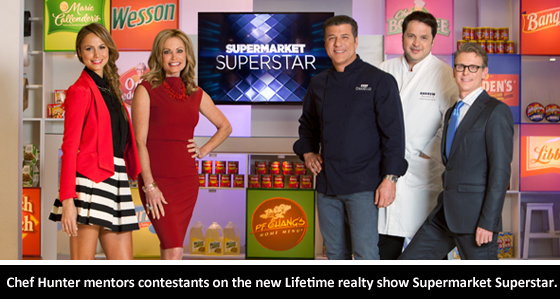
HUNTER: There’s like 20,000 things. They really have no idea what’s involved in the process. And in many ways that’s part of the hook of the show. In some ways the less idea you have or the less understanding you have of how the process really works, the better contestant you are. Especially if you listen to the mentor’s advice.
And you don’t have to listen to the mentor’s advice. There is one episode coming up where the person that wins completely refuted everything we [the mentors] said. And yet, that person still won. The consumer panel had a huge impact on the decisions that were made internally and behind the scenes.Unfortunately, those who watch the show don’t get to see the amount of work and time I, and the other mentors, spend with the contestants. We work for hours and hours to transform these products with the contestants. And there were really two sessions in the kitchen, but only one gets aired.
I think the most difficult thing for me was to explain to the contestants how critical their selection of ingredients was. For example, the winner of the first episode, Latrice, it was really hard for her to grasp that she couldn’t use peaches from the farmer’s market for her peach cobbler cupcakes. She didn’t have to use canned peaches. She didn’t have to use peaches that had been loaded with sulphites and all sorts of things. She could use a peach that has an ingredient deck that said “peaches.” But it was an IQ apt diced peach. And one of the things that I tried to convey to them is that actually the IQ apt diced peach is a better product than a peach from the farmer’s market in this application.
If it’s summertime and I’m walking through a farmer’s market, and I have a choice between fresh organic peaches and a freezer case with diced peaches, obviously we’re all picking the farmer’s market peach. But we can’t use the farmer’s market peach in a product. Some of it is cost, but a lot of it is consistency. And it’s also the processes that are set up to grow, pick, and process the peaches, for example, in a way that gets them ready for processing. Whereas, if you pick peaches from the tree then you have to go through that whole process. Why not just make a good selection of an ingredient from the manufacturer that abides by the principles that you abide by.
And then the other challenge was getting them to understand some of the scientific concepts of some of the starches and gels that are really necessary. So for example, Hannah was in an earlier episode and won with her whoopie pie. Part of the reason that her product won is that she was willing to use cellulose that helped hold her cream together through the freeze, thaw cycle and also give it the stability that it needed to not completely squish out the sides.
And the other thing that I think it’s kinda cool—possibly for the IFT readers to know—is that when Hannah brought her whoopie pies to the buyer, they had been frozen and thawed. So they had gone through a bench-top process. Obviously, they hadn’t gone through a spiral—a spiral freezer held for six months and all of that kind of thing. But they had been made, assembled, frozen, thawed, and then presented to the buyer. These are some of the behind-the-scenes stuff that’ll never be seen. We tried as best we could in a sort of a bench-top process to emulate a pilot or manufacturing process with a lot of these products.
HENSEL: Shows like Supermarket Superstar demonstrate that cooking has moved from what we used to do in the kitchens with our moms and dads to more of this entertainment factor for the masses. From your perspective, where do you see that movement going and how might it impact culinary creation or how food is made in the future?
HUNTER: Well, first of all, I think it has been a blessing to the culinary profession. I always remember when I was fairly new out of culinary school, I went to a recruiter in San Francisco who’s still in business and who shall remain nameless; and she said to me, “Come to terms with this Andrew. You are in a blue-collar occupation. And you will do better once you realize and accept that.” And I walked away practically in tears. Not that I think that there’s by any stretch that blue-collar professions aren’t worthwhile because they are. But I just didn’t think I was in one. I think what the Food Network and chefs like Wolfgang, Rick Bayless, Mark Miller, these guys pioneered the process from what was strictly a trade into something that was really more of a profession.
One time I wore my chef jacket on a plane because I didn’t have time to change out of it, and I promised myself I would never do that again. I swear people were in the aisle wanting to talk. So there’s this fascination with chefs. And so much of it is attributable to the Food Network. And people like Anthony Bourdain who really caught the nation’s imagination.
I guess what I would be concerned a little bit about—at least from the television angle—is that we’re running out of materials to some degree. I think we need to figure out how to not make everything a crazy kitchen experience. But nonetheless, when I’m walking down the street or whenever somebody learns I’m a chef, they say oh, my children watch the Food Network. That’s what they watch. It gives me great satisfaction because it means that they’re not watching any number of other things that they could be watching. And by and large culinary television programming is really quite wholesome.
And at this point, I think a lot of times one of the metrics of a chef’s success is whether or not he or she has been on TV.
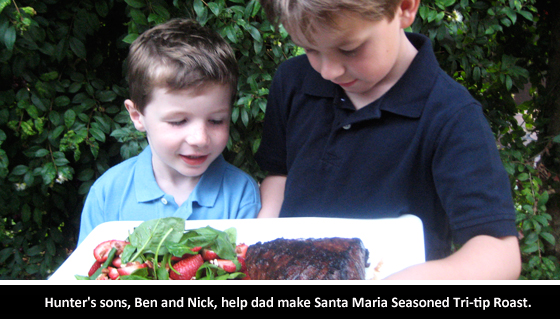
Santa Maria Seasoned Tri-tip Roast
by Chef Andrew Hunter
The indoor-outdoor meals of summer are a real joy at the Hunter house. It’s partly because they’re delicious, partly because they’re easy, and partly because the sun has mellowed just enough for a cool night on the patio. But most importantly, because preparing dinner is a family affair. Tonight, Nick washed and spun the spinach, Ben sliced the strawberries, Marilyn put the Santa Maria dry rub on the meat, and I opened the wine. Together, we grilled the tri-tip, poked at it then licked the salty seasoning from our fingers, and debated the whole time about when it would be done.
Tri-tip is a California classic, and Santa Maria seasoning is the best. It’s a triangular piece cut from the sirloin. Weighing in at about two pounds, an average tri-tip grilled for Saturday supper is plenty to feed four hungry people with enough left for Sunday morning steak and eggs.
Santa Maria Tri-tip Roast
Combine all ingredients in a small bowl and rub all sides of the roast to coat. Place the seasoned roast on a plate and refrigerate—don’t cover it with plastic because the meat needs to breathe. Take it out of the fridge 30 minutes before grilling. Place it on a hot grill, turning occasionally, and cook until it’s about 145 degrees on the thin end and 130 degrees on the thick end. Let the meat rest for 10 minutes, then slice it across the grain and serve with your favorite summer salad. Ours is baby spinach, sliced strawberries, and toasted pecans tossed with sweet balsamic vinaigrette.Dry Rub:
2 teaspoons Kosher salt
¼ teaspoon freshly ground black pepper
¼ teaspoon paprika
½ teaspoon garlic powder
½ teaspoon onion powder
Because the roast is shaped like a triangle with the narrow end thin and the wide end thick, it’s difficult to overcook. I slice the boys’ medium well portion from the tip and our medium rare portion from the base. I also like to arrange the salad on one end of the platter with the grilled tri-tip on the other. Allow the meat to rest for ten minutes or so, then slice it right on the platter. The juices, combined with a drizzle of the sweet balsamic vinaigrette, makes the best salad dressing on earth.


